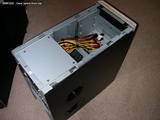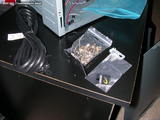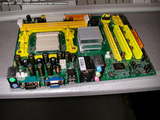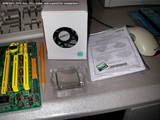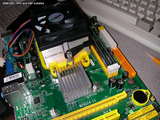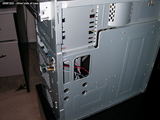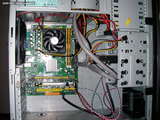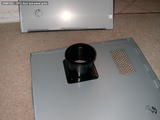Satya's blog - Build notes for the Windows/Game system
Objective: a sub-$200 (in new parts) gaming computer capable of playing a not-too-demanding modern game like Battlefield 2 without a lot of lag.
I'll be using the old 80GB IDE hard drive in this one, with a 20GB Windows partition and the rest for data. I'll also be using an nVidia GeForce 6600LE that I bought for the other computer and didn't use (since the other one had an HDMI-to-DVI adapter). The 6600 is supposed to be better than the 6100, and anyway the on-board one supposedly uses system RAM instead of dedicated VRAM. The AMD CPU is about $40-$50 cheaper than a comparable Intel CPU. My alternative was the Intel Wolfdale E5200 at $82, but it is dual-core unlike this AMD Sempron. That dictated the choice of motherboard, which is simply the cheapest one with AMD support and a PATA connection. I want analog video out (VGA) anyway, because of the way I have the shared monitor hooked up. 2GB for the RAM, because 1 isn't enough and Windows XP is supposed to choke on anything more than 3. Since the board and RAM are dual-channel, 2GB it is. With the IDE hard drive and IDE DVD drive, I made sure to get a case where all the drives mount in the same direction. But I still had to use the long cable I bought for the other build. Apparently it works with everything but the DVD burner I have, and I need DVD burning in my primary Linux box, and I don't need it in my game box. So the game box has a DVD-ROM drive in it and seems to work with the long PATA cable. Antec supposedly makes good cases, so there we go, it's the cheapest Antec case that fulfills my needs. I will install the CPU and RAM on the motherboard first, before opening the case. But I will need to open the case to ground myself. The case opens at the top with 2 thumbscrews. Sharp-ish edges as noted in the reviews, but come on, it's a steel case. Be careful. The side panels lift up and out, and even the front panel is fairly easy to remove as long as you can pull the panel while releasing each of the 6 tabs, tightest one first in lockpicker-style. The case contains the usual spare hardware, screws and so on, and a power cable. It has a rear 120mm fan with speed control switch, a CPU duct, and no other fans besides the PSU (power supply). There is a bracket for a front 80mm fan, and the ability to mount one under the side duct. Cute. There's a loose piece of 8-inch cable tie in there. There's a plastic wrap-tie in the screws pouch, along with a case badge and an unexplained metal bracket. With this 380W PSU, I have to watch my power consumption. I'm not sticking anything complex in there. Besides the inventory above, it's going to be a hard drive, an optical drive, and an nVidia GeForce 6600. The hard drive cage is detachable, which is good because there are no drive trays. It's hard to screw in a hard drive while supporting it with one hand inside a cramped box. Eww, the 5.25" optical drive bays have pop-off metal covers. At least the gap left by them will be covered by the front panel's more-modern re-attachable plastic covers. Isn't this nice: the front plate bezel pops off completely. I can stick an air filter in there, but who's going to clean it, and when? The case has several air holes. I'd like to cover those with filters, but again who's going to clean/change them? Hmm, front panel comes apart into two pieces. Handy. Motherboard box comes with the usual manual, driver disk, back plate, 2 SATA and 1 PATA cables, and the board. This board takes 24pin ATX power (with the last 4 pins covered by a removeable tab, what's up with that?) plus 4-pin power connection, plus CPU power connection. I have broken the seal on the CPU box. As usual with current CPU retail boxes, it's filled mostly with heatsink and manual. I hope it comes pre-greased, as I don't have any thermal grease. It does come pre-greased. Adding the HSF (heatsink-fan combo) is a little easier on this than on the Intel board, maybe because I'm doing it before inserting into the case. The RAM was a little hard to get out of it's packaging, but it's in there now. It's uncomfortably close to the CPU, and I'm worried about heat. AMD CPUs have historically run pretty hot. The Northbridge heatsink is also pretty close to the CPU. Case feels pretty light with all the panels off. The stock back panel (over the rear mobo connectors) is wedged in real good, had to hammer on it with the handle of a large pair of scissors. Unlike the other Zotac board, this mobo one has just 6 screw holes for attaching to the case. Okay, the metal grilles over the 5.25" bays are practically impossible to break off by hand. Only the top bay is open and given that this is an all-PATA system with a board that has only 1 PATA connector, I need to make sure the IDE cables will fit with the optical drive in the top bay. I don't want to use the extra-long cable I have because I suspect it has issues. It's not easy to detach the hard drive cage as there are two screws under it, in an awkward position even with the case laying on its side and not full of dust. The cage does have metal tabs, so you don't have to use one hand to awkwardly hold up the drive while using a second to hold the screw and a third to turn the screwdriver. There are holes in the right-side of the case for hard drive screw access. The hard drive bays have silicone grommets, and the long screws necessary are included with the case. A long magnetic screwdriver is also needed to get in from the right. When I am ruler of the universe all PCI and similar cards will have handles to pull them out. Oh, neat, the rear slot covers pull out. I thought they would have to be broken off, since they lack screws. But they're just held in place by friction. With the video card installed, I notice that the large heatsink on the GPU (Graphics Processing Unit) and VRAM (Video RAM) is below the card when the case is in its operating position. Anyone else notice that heat rises? I guess it's supposed to be more of a radiator and spreader than a convective cooler, but still. I knew I did something stupid: badge on front of case has been glued upside down. Due to the CPU duct and the way the side panel closes (it slides down from above by about half an inch) it's a little hard to close, especially with my big IDE cable in there. The duct helps move the cables away from the CPU and the video card, though, but I should route them better. Which I have now done. The side panel closes a little easier now. Sure, the fan wires are taped to the bottom of the PSU, but who cares. I've added a few air filter swatches inside the side panel grille and in the CPU duct. This power supply, an Antec Earthwatts 380W, also has a hard switch on the back. Powering up.... Well, that's interesting. My ancient Windows XP boot CD does not recognize the on-board network adapter. Oh, well. Either it'll be on the motherboard's disc or I can find a generic one online and transfer visa USB. Here's a hint, though, my XP disc may not work on new computers much longer. Or are modern CPUs still capable of emulating 8086 and Pentium? Interesting, XP detected the network right after installing the drivers from the mobo disc. No reboot needed. But I don't think it's doing very well with the video -- dragging a window is slow and jerky. Bet it doesn't have the drivers. (Yes, installing the drivers made it much better.) How bad is it to reverse the polarity of the electron flow across a photon emitter? Translation: I plugged in the power LED backwards Downloaded the nVidia drivers. 80 megabytes, sigh. Installing now. My standard loadout for a Windows system includes Firefox, AVG Free, and Zonealarm free, and I'm adding WinSCP to this system. I also installed a motherboard monitoring app from the mobo disc, as well as sound, network, and System Management Bus (SM Bus) drivers. Eventually the Windows Device Manager stopped showing yellow exclamations or red whatevers. Also downloaded the latest Quicktime, because Septerra Core keeps crashing on startup. I wonder what else is missing or unsupported. New system doesn't feel very fast, despite turning off all the eyecandy stuff that Windows brings in (the equivalent of turning off Compiz, I guess). Battlefield 2 seems to run better. According to the mobo monitor, system temperature is about 85 degrees Fahrenheit and CPU varies about 90-96 Fahrenheit. According to my wattmeter it takes 60 to 90 watts and about 750mA. |
|
